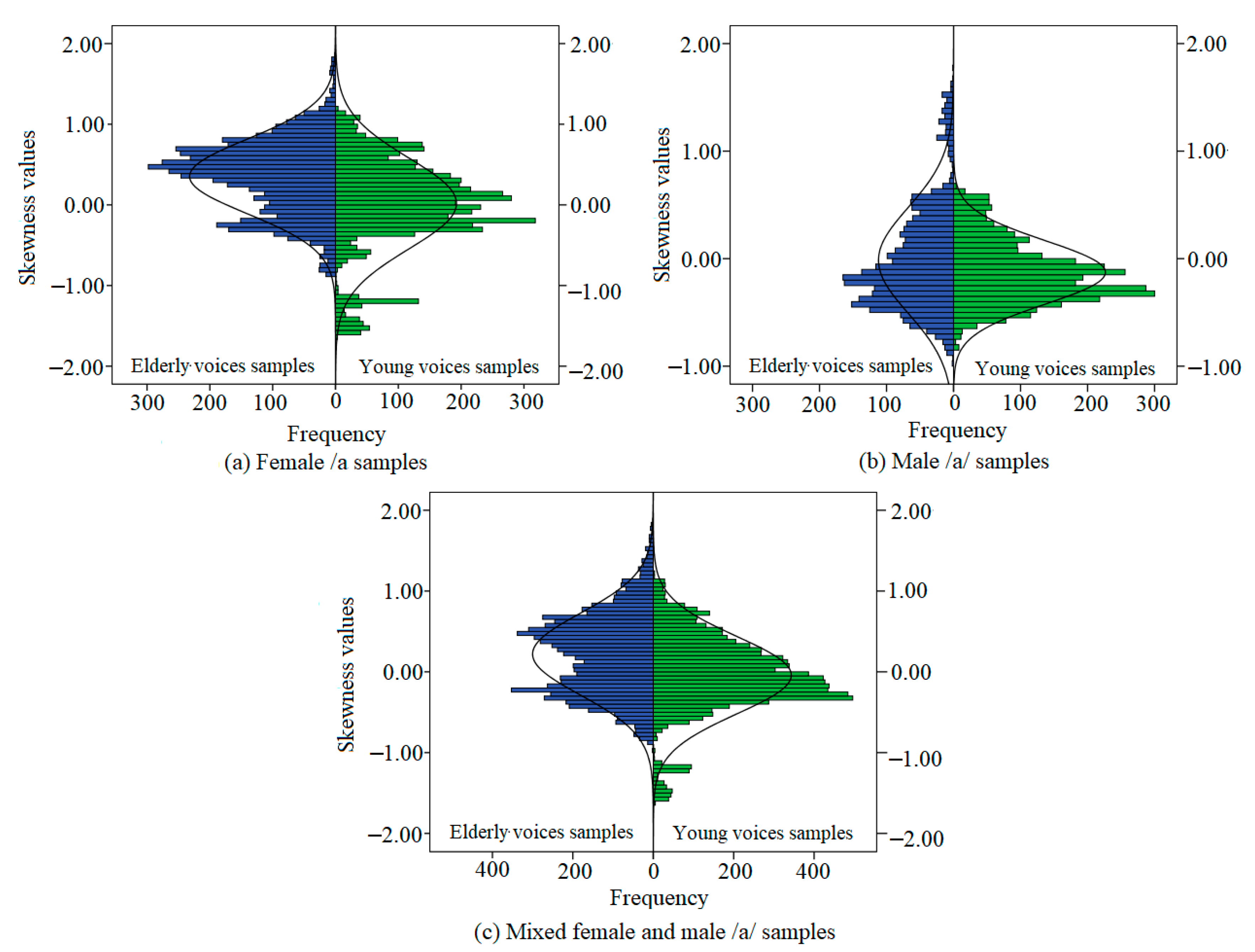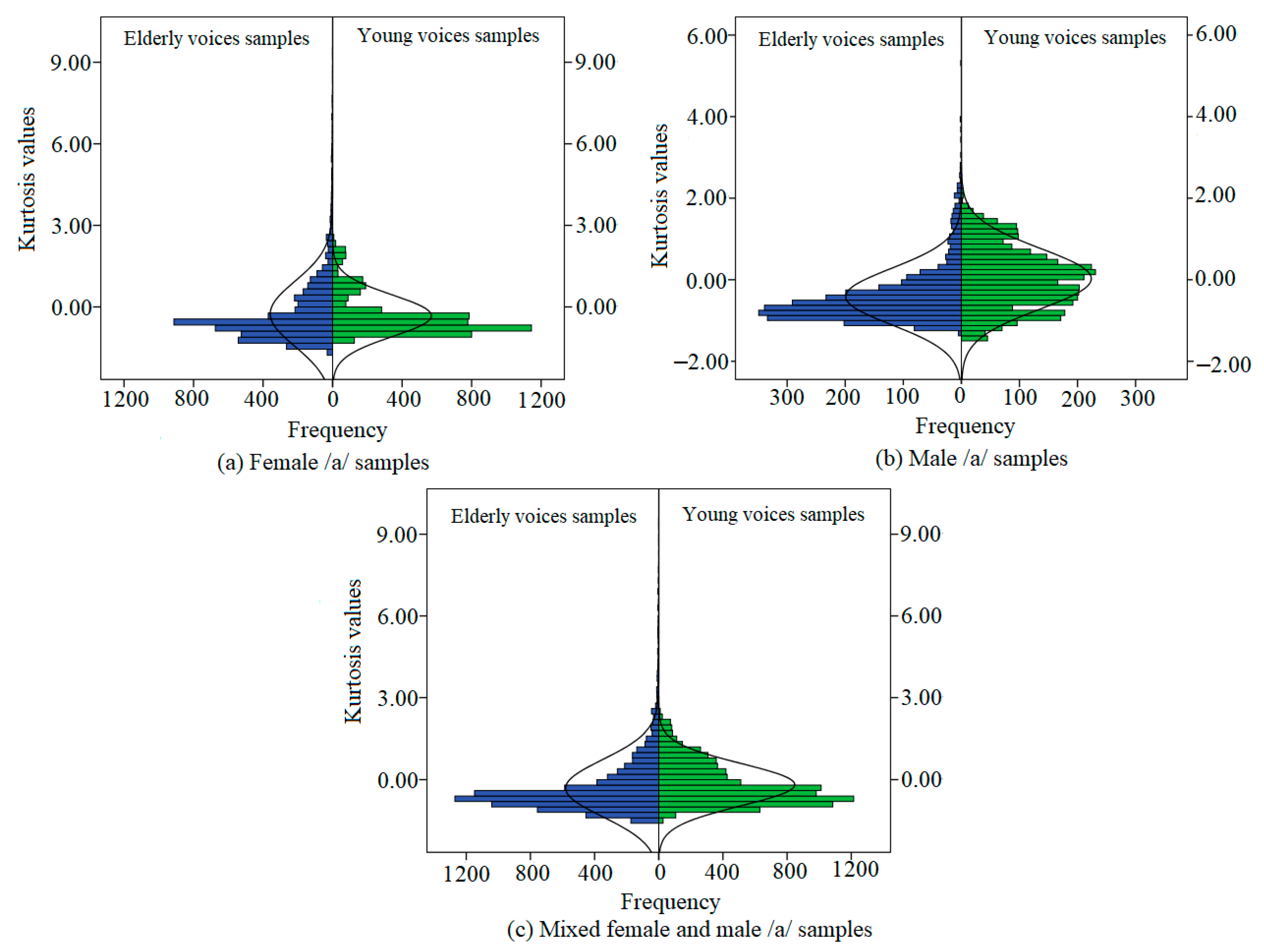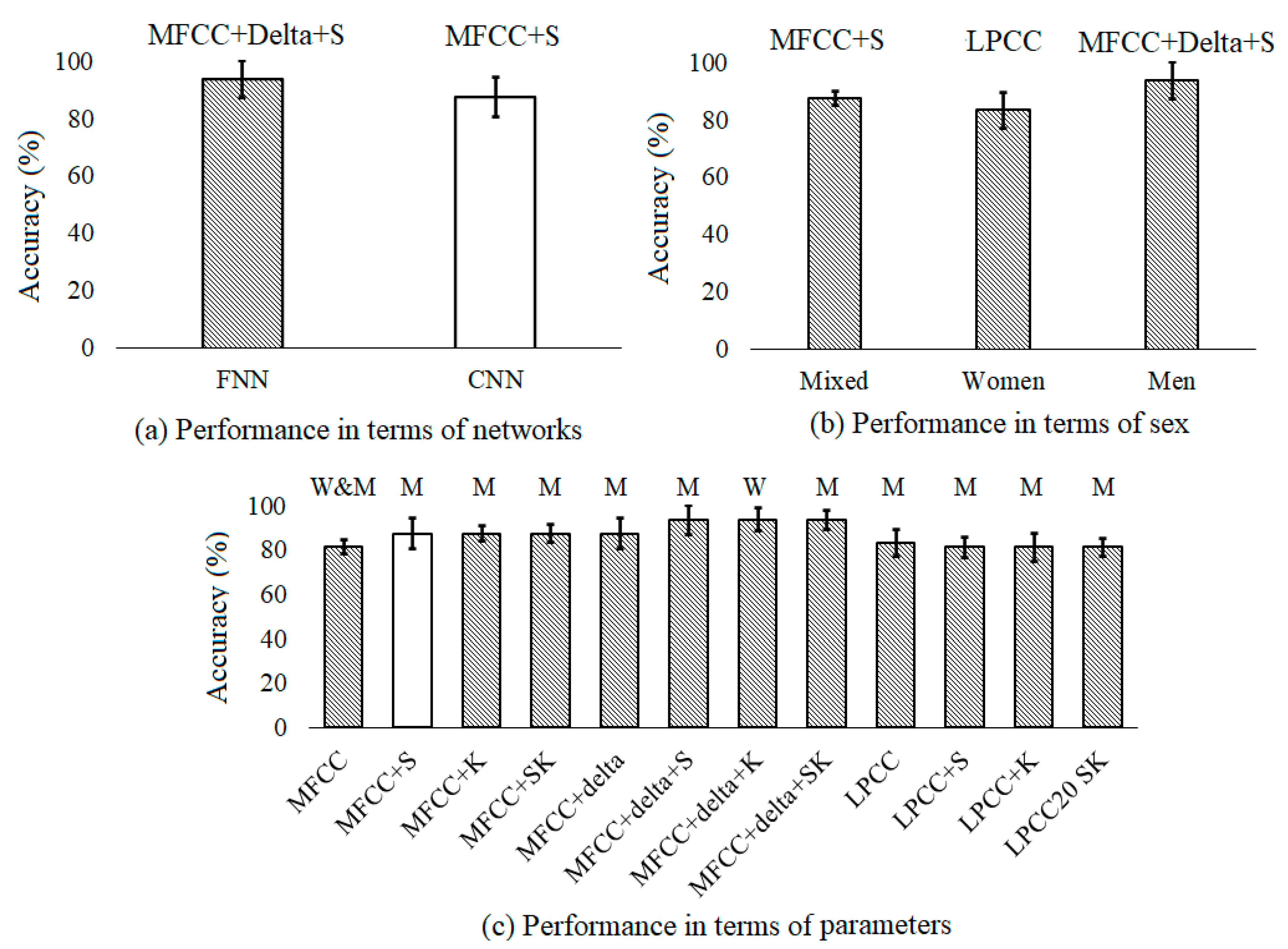Classification between Elderly Voices and Young Voices Using an Efficient Combination of Deep Learning Classifiers and Various Parameters
Abstract
1. Introduction
- This paper introduces an intelligent elderly voice classification system based on deep learning classifiers and various parameters.
- The suggested combinations of various parameters and deep learning methods can effectively distinguish young from elderly voices.
- A lot of experimental tests are performed to confirm the effectiveness of the elderly voice classification system using the Saarbruecken voice database.
- The experimental results emphasize the superiority of the proposed elderly voice classification system integrating deep learning methods and various parameters to monitor an elderly voice for an effective and reliable system.
2. Materials and Methods
2.1. Database
2.2. Feature Parameters
2.3. Deep Learning Classifiers
3. Experimental Results and Discussion
4. Conclusions
Funding
Conflicts of Interest
References
- Asci, F.; Costantini, G.; Di Leo, P.; Zampogna, A.; Ruoppolo, G.; Berardelli, A.; Saggio, G.; Suppa, A. Machine-Learning Analysis of Voice Samples Recorded through Smartphones: The Combined Effect of Ageing and Gender. Sensors 2020, 20, 5022. [Google Scholar] [CrossRef]
- Mezzedimi, C.; Di Francesco, M.; Livi, W.; Spinosi, M.C.; De Felice, C. Objective Evaluation of Presbyphonia: Spectroacoustic Study on 142 Patients with Praat. J. Voice 2017, 31, 257.e25–257.e32. [Google Scholar] [CrossRef]
- Gonçalves, T.M.; Dos Santos, D.C.; Pessin, A.B.B.; Martins, R.H.G. Scanning Electron Microscopy of the Presbylarynx. Otolaryngol. Head Neck Surg. 2016, 154, 1073–1078. [Google Scholar] [CrossRef]
- Hammond, T.H.; Gray, S.D.; Butler, J.; Zhou, R.; Hammond, E. Age- and gender-related elastin distribution changes in human vocal folds. Otolaryngol. Head Neck Surg. 1998, 119, 314–322. [Google Scholar] [CrossRef]
- Choi, H.J.; Lee, J.Y. Comparative Study between Healthy Young and Elderly Subjects: Higher-Order Statistical Parameters as Indices of Vocal Aging and Sex. Appl. Sci. 2021, 11, 6966. [Google Scholar] [CrossRef]
- Kahane, J.C. Anatomic and physiologic changes in the aging peripheral speech mechanism. In Aging: Communications Processes and Disorders; Beasley, D.S., Davis, A., Eds.; Grune and Stratton: New York, NY, USA, 1981; pp. 21–45. [Google Scholar]
- Lee, S.Y. The Overall Speaking Rate and Articulation Rate of Normal Elderly People. Graduate Program in Speech and Language Pathology. Master’s Thesis, Yonsei University, Seoul, Korea, 2011. [Google Scholar]
- Kadiri, S.R.; Gangamohan, P.; Gangashetty, S.V.; Alku, P.; Yegnanarayana, B. Excitation Features of Speech for Emotion Recognition Using Neutral Speech as Reference. Circuits Syst Signal Process 2020, 39, 4459–4481. [Google Scholar] [CrossRef]
- Kadiri, S.R.; Gangamohan, P.; Yegnanarayana, B. Discriminating Neutral and Emotional Speech Using Neural Networks. ICON 2014. Available online: https://aclanthology.org/W14-5132 (accessed on 13 May 2018).
- Byeon, H. Comparing Ensemble-Based Machine Learning Classifiers Developed for Distinguishing Hypokinetic Dysarthria from Presbyphonia. Appl. Sci. 2021, 11, 2235. [Google Scholar] [CrossRef]
- Fukuda, M.; Nishimura, R.; Nishizaki, H.; Iribe, Y.; Kitaoka, N. A New Corpus of Elderly Japanese Speech for Acoustic Modeling, and a Preliminary Investigation of Dialect-Dependent Speech Recognition. In Proceedings of the 2019 22nd Conference of the Oriental COCOSDA International Committee for the Coordination and Standardization of Speech Databases and Assessment Techniques (O-COCOSDA), Cebu, Philippines, 25–27 October 2019; pp. 1–6. [Google Scholar]
- Werner, L.; Huang, G.; Pitts, B.J. Automated Speech Recognition Systems and Older Adults: A Literature Review and Synthesis. Proc. Hum. Factors Ergon. Soc. Annu. Meeting. 2019, 63, 42–46. [Google Scholar] [CrossRef]
- Ambrosini, E.; Caielli, M.; Milis, M.; Loizou, C.; Azzolino, D.; Damanti, S.; Bertagnoli, L.; Cesari, M.; Moccia, S.; Cid, M.; et al. Automatic speech analysis to early detect functional cognitive decline in elderly population. In Proceedings of the Annual International Conference of the IEEE Engineering in Medicine and Biology Society, Berlin, Germany, 23–27 July 2019; pp. 212–216. [Google Scholar] [CrossRef]
- Forero Mendoza, L.A.; Cataldo, E.; Vellasco, M.; Silva, M. Classification of Voice Aging Using Parameters Extracted from the Glottal Signal. In Artificial Neural Networks—ICANN 2010; Diamantaras, K., Duch, W., Iliadis, L.S., Eds.; ICANN 2010; Lecture Notes in Computer Science; Springer: Berlin/Heidelberg, Germany, 2010; Volume 6354. [Google Scholar]
- Collado-Villaverde, A.; R-Moreno, M.D.; Barrero, D.F.; Rodriguez, D. Machine Learning Approach to Detect Falls on Elderly People Using Sound. In Advances in Artificial Intelligence: From Theory to Practice; Benferhat, S., Tabia, K., Ali, M., Eds.; IEA/AIE 2017; Lecture Notes in Computer Science; Springer: Cham, Switzerland, 2017; Volume 10350. [Google Scholar]
- Vacher, M.; Aman, F.; Rossato, S.; Portet, F. Development of Automatic Speech Recognition Techniques for Elderly Home Support: Applications and Challenges. In Human Aspects of IT for the Aged Population; Zhou, J., Salvendy, G., Eds.; Design for Everyday Life ITAP 2015; Lecture Notes in Computer Science; Springer: Cham, Switzerland, 2015; Volume 9194. [Google Scholar]
- Solano, A.; López, G.; Guerrero, L.; Quesada, L. User Experience Evaluation of Voice Interfaces: A Preliminary Study of Games for Seniors and the Elderly. Proceedings 2019, 31, 65. [Google Scholar] [CrossRef]
- Yang, G.; Yang, J.; Sheng, W.; Junior, F.E.F.; Li, S. Convolutional Neural Network-Based Embarrassing Situation Detection under Camera for Social Robot in Smart Homes. Sensors 2018, 18, 1530. [Google Scholar] [CrossRef]
- Lee, J.Y. Gender analysis in elderly speech signal processing. J. Digital Converg. 2018, 16, 351–356. [Google Scholar] [CrossRef]
- Lee, J.Y. Elderly speech signal processing: A systematic review for analysis of gender innovation. J. Converg. Inf. Technol. 2019, 9, 148–154. [Google Scholar] [CrossRef]
- Ferrand, C.T. Harmonics-to-noise ratio: An index of vocal aging. J. Voice 2002, 16, 480–487. [Google Scholar] [CrossRef]
- da Silva, P.T.; Master, S.; Andreoni, S.; Pontes, P.; Ramos, L.R. Acoustic and long-term average spectrum measures to detect vocal aging in women. J. Voice 2011, 25, 411–419. [Google Scholar] [CrossRef]
- Maslan, J.; Leng, X.; Rees, C.; Blalock, D.; Butler, S.G. Maximum phonation time in healthy older adults. J. Voice 2011, 25, 709–713. [Google Scholar] [CrossRef]
- Schaeffer, N.; Knudsen, M.; Small, A. Multidimensional Voice Data on Participants with Perceptually Normal Voices from Ages 60 to 80: A Preliminary Acoustic Reference for the Elderly Population. J. Voice 2015, 29, 631–637. [Google Scholar] [CrossRef]
- Linville, S.E.; Rens, J. Vocal Tract Resonance Analysis of Aging Voice Using Long-Term Average Spectra. J. Voice 2001, 15, 323–330. [Google Scholar] [CrossRef]
- Peterson, E.A.; Roy, N.; Awan, S.N.; Merrill, R.Y.; Banks, R.; Tanner, K. Toward validation of the cepstral spectral index of dysphonia (CSID) as an objective treatment outcomes measure. J. Voice 2013, 27, 401–410. [Google Scholar] [CrossRef]
- Byeon, H.; Jin, H.; Cho, S. Characteristics of hypokinetic dysarthria patients’ speech based on sustained vowel phonation and connected speech. Int. J. Serv. Sci. Technol. 2016, 9, 417–422. [Google Scholar] [CrossRef]
- Lee, J.-Y. Experimental Evaluation of Deep Learning Methods for an Intelligent Pathological Voice Detection System Using the Saarbruecken Voice Database. Appl. Sci. 2021, 11, 7149. [Google Scholar] [CrossRef]
- William, J.B.; Manfred, P. Saarbrucken Voice Database. Institute of Phonetics, Univ. of Saarland. Available online: http://www.stimmdatenbank.coli.uni-saarland.de/2007 (accessed on 13 May 2018).
- Oh, S.L.; Vicnesh, J.; Ciaccio, E.J.; Yuvaraj, R.; Acharya, U.R. Deep Convolutional Neural Network Model for Automated Diagnosis of Schizophrenia Using EEG Signals. Appl. Sci. 2019, 9, 2870. [Google Scholar] [CrossRef]
- Phang, C.R.; Ting, C.M.; Noman, F.; Ombao, H. Classification of EEG-Based Brain Connectivity Networks in Schizophrenia Using a Multi-Domain Connectome Convolutional Neural Network. arXiv 2019, arXiv:1903.08858. [Google Scholar]
- Davis, S.; Mermelstein, P. Comparison of parametric representations for monosyllabic word recognition in continuously spoken sentences. IEEE Trans. Acoust. Speech Signal Process. 1980, 28, 357–366. [Google Scholar] [CrossRef]
- Thomas, D.W. Linear Prediction of Speech; Markel, J.D., Gray, A.H., Eds.; Springer: Berlin/Heidelberg, Germany; New York, NY, USA, 1976; p. xii+288 Cloth. ISBN 3-540-07563-1. [Google Scholar]
- Nemer, E.; Goubran, R.; Mahmoud, S. Robust voice activity detection using higher-order statistics in the LPC residual domain. IEEE Trans. Speech Audio Process. 2001, 9, 217–231. [Google Scholar] [CrossRef]
- Lee, J.-Y.; Jeong, S.; Hahn, M. Pathological Voice Detection Using Efficient Combination of Heterogeneous Features. IEICE Trans. Inf. Syst. 2008, E91-D, 367–370. [Google Scholar] [CrossRef][Green Version]
- Wikipedia. Histogram. Available online: https://en.wikipedia.org/wiki/Histogram (accessed on 9 June 2021).
- Adam, P.; Sam, G.; Soumith, C.; Gregory, C. Automatic differentiation in PyTorch. In Proceedings of the 31st Conference on Neural Information Processing Systems (NIPS 2017), Long Beach, CA, USA, 4–9 December 2017. [Google Scholar]
- Lee, J.Y.; Hahn, M. Automatic Assessment of Pathological Voice Quality Using Higher-Order Statistics in the LPC Residual Domain. EURASIP J. Adv. Signal Process. 2010, 2009, 1–8. [Google Scholar] [CrossRef][Green Version]
- Wang, X.; Zhang, J.; Yan, Y. Discrimination between Pathological and Normal Voices Using GMM-SVM Approach. J. Voice 2011, 25, 38–43. [Google Scholar] [CrossRef]
- Song, Y.-K. Prevalence of Voice Disorders and Characteristics of Korean Voice Handicap Index in the Elderly. Phon. Speech Sci. 2012, 4, 151–159. [Google Scholar] [CrossRef][Green Version]
- Lee, S.J.; Kwon, S.I. Elderly speech analysis for improving elderly speech recognition. J. Korean Inst. Inf. Sci. Eng. 2014, 32, 16–20. [Google Scholar]
- Jeong, J.H.; Jang, J.H.; Moon, M. Development of AI Speaker with Active Interaction Customized for the Elderly. J. Korean Inst. Electron. Commun. Sci. 2020, 15, 1223–1230. [Google Scholar]





| Number of Samples | Mean Age | Standard Deviation Age | |
|---|---|---|---|
| Men (age) | |||
| 22–59 | 24 | 39.13 | 12.76 |
| 60–89 | 24 | 72.2 | 7.28 |
| Women (age) | |||
| 20–58 | 39 | 39.12 | 12.57 |
| 60–87 | 39 | 70.7 | 8.27 |
| Parameter | Value | |
|---|---|---|
| Loss function | Tanh | |
| Optimization algorithm | SGD + momentum | |
| Regularization | L2 | |
| Mismatch propagation | BPTT | |
| Minibatch size | 100 samples | |
| Learning rate | 0.001 or 0.00001 exponential attenuation | |
| Loss function | Cross-entropy | |
| Weights for samples | Yes | |
| Parameter | Value | |
|---|---|---|
| Activation function | ReLU | |
| Kernel size | (2, 2) | |
| Optimizer | Adam | |
| Epoch | 100 | |
| Loss function | Cross-entropy | |
| Dropout | 0.05 | |
| Pooling window | Max-pooling (2, 2) | |
| Neurons at the dense layer | 512 | |
| MFCC | MFCC + S | MFCC + K | MFCC + SK | ||
|---|---|---|---|---|---|
| FNN | |||||
| /a/ | Women and men | 81.58 ± 3.30 | 87.50 ± 2.31 | 78.95 ± 2.07 | 81.58 ± 3.72 |
| Women | 75.00 ± 4.12 | 75.00 ± 3.67 | 75.00 ± 2.95 | 75.00 ± 3.61 | |
| Men | 81.25 ± 3.02 | 87.50 ± 3.23 | 87.50 ± 3.28 | 87.50 ± 3.95 | |
| CNN | |||||
| /a/ | Women and men | 78.95 ± 3.73 | 73.68 ± 2.22 | 73.68 ± 2.71 | 78.95 ± 6.35 |
| Women | 70.83 ± 3.54 | 75.00 ± 3.95 | 70.83 ± 4.39 | 75.00 ± 2.81 | |
| Men | 81.25 ± 3.55 | 87.50 ± 6.87 | 81.25 ± 7.33 | 75.00 ± 5.14 |
| MFCC + Delta | MFCC + Delta + S | MFCC + Delta + K | MFCC + Delta + SK | ||
|---|---|---|---|---|---|
| FNN | |||||
| /a/ | Women and men | 76.32 ± 3.47 | 78.95 ± 1.58 | 76.32 ± 1.94 | 78.95 ± 3.54 |
| Women | 79.17 ± 2.95 | 75.00 ± 2.95 | 75.00 ± 3.61 | 75.00 ± 2.94 | |
| Men | 87.50 ± 7.10 | 93.75 ± 6.59 | 93.75 ± 5.15 | 93.75 ± 4.37 | |
| CNN | |||||
| /a/ | Women and men | 78.95 ± 3.46 | 76.32 ± 4.07 | 78.95 ± 2.82 | 73.68 ± 2.61 |
| Women | 75.00 ± 2.91 | 75.00 ± 3.95 | 75.00 ± 4.91 | 70.83 ± 2.81 | |
| Men | 68.75 ± 5.27 | 81.25 ± 8.04 | 81.25 ± 4.88 | 75.00 ± 3.29 |
| LPCC | LPCC + S | LPCC + K | LPCC + SK | ||
|---|---|---|---|---|---|
| FNN | |||||
| /a/ | Women and men | 78.95 ± 3.73 | 78.95 + 2.54 | 73.68 + 3.08 | 76.32 + 3.55 |
| Women | 83.33 ± 6.24 | 79.17 + 2.95 | 79.17 + 3.03 | 79.17 + 3.02 | |
| Men | 81.25 ± 3.23 | 81.25 + 4.37 | 81.25 + 6.07 | 81.25 + 4.22 | |
| CNN | |||||
| /a/ | Women and men | 63.16 + 3.29 | 63.16 + 3.88 | 63.16 + 4.47 | 68.42 + 4.26 |
| Women | 66.67 + 2.81 | 70.83 + 2.91 | 75.00 + 4.41 | 70.83 + 2.36 | |
| Men | 68.75 + 4.37 | 68.75 + 4.22 | 68.75 + 5.47 | 75.00 + 4.93 |
Publisher’s Note: MDPI stays neutral with regard to jurisdictional claims in published maps and institutional affiliations. |
© 2021 by the author. Licensee MDPI, Basel, Switzerland. This article is an open access article distributed under the terms and conditions of the Creative Commons Attribution (CC BY) license (https://creativecommons.org/licenses/by/4.0/).
Share and Cite
Lee, J.-Y. Classification between Elderly Voices and Young Voices Using an Efficient Combination of Deep Learning Classifiers and Various Parameters. Appl. Sci. 2021, 11, 9836. https://doi.org/10.3390/app11219836
Lee J-Y. Classification between Elderly Voices and Young Voices Using an Efficient Combination of Deep Learning Classifiers and Various Parameters. Applied Sciences. 2021; 11(21):9836. https://doi.org/10.3390/app11219836
Chicago/Turabian StyleLee, Ji-Yeoun. 2021. "Classification between Elderly Voices and Young Voices Using an Efficient Combination of Deep Learning Classifiers and Various Parameters" Applied Sciences 11, no. 21: 9836. https://doi.org/10.3390/app11219836
APA StyleLee, J.-Y. (2021). Classification between Elderly Voices and Young Voices Using an Efficient Combination of Deep Learning Classifiers and Various Parameters. Applied Sciences, 11(21), 9836. https://doi.org/10.3390/app11219836





